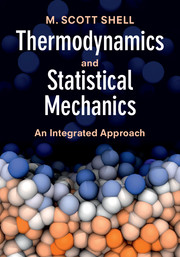Book contents
- Frontmatter
- Contents
- Preface
- Reference tables
- 1 Introduction and guide for this text
- 2 Equilibrium and entropy
- 3 Energy and how the microscopic world works
- 4 Entropy and how the macroscopic world works
- 5 The fundamental equation
- 6 The first law and reversibility
- 7 Legendre transforms and other potentials
- 8 Maxwell relations and measurable properties
- 9 Gases
- 10 Phase equilibrium
- 11 Stability
- 12 Solutions: fundamentals
- 13 Solutions: advanced and special cases
- 14 Solids
- 15 The third law
- 16 The canonical partition function
- 17 Fluctuations
- 18 Statistical mechanics of classical systems
- 19 Other ensembles
- 20 Reaction equilibrium
- 21 Reaction coordinates and rates
- 22 Molecular simulation methods
- Index
- References
15 - The third law
Published online by Cambridge University Press: 05 April 2015
- Frontmatter
- Contents
- Preface
- Reference tables
- 1 Introduction and guide for this text
- 2 Equilibrium and entropy
- 3 Energy and how the microscopic world works
- 4 Entropy and how the macroscopic world works
- 5 The fundamental equation
- 6 The first law and reversibility
- 7 Legendre transforms and other potentials
- 8 Maxwell relations and measurable properties
- 9 Gases
- 10 Phase equilibrium
- 11 Stability
- 12 Solutions: fundamentals
- 13 Solutions: advanced and special cases
- 14 Solids
- 15 The third law
- 16 The canonical partition function
- 17 Fluctuations
- 18 Statistical mechanics of classical systems
- 19 Other ensembles
- 20 Reaction equilibrium
- 21 Reaction coordinates and rates
- 22 Molecular simulation methods
- Index
- References
Summary
In Chapters 4 and 5 we introduced the molecular basis for the first two laws of thermodynamics. In particular, we developed a physical interpretation for the entropy in terms of microstates. However, we have yet to address two subtle questions regarding this relationship. Is there any such thing as an absolute value of the entropy? That is, does it make sense to identify an exact numerical value of S for a particular system and a particular state point, as opposed to the more modest calculation of a change in entropy between two state points? Furthermore, what is the behavior of the entropy and other thermodynamic functions as the temperature approaches absolute zero?
As we shall see in this chapter, both of these questions cannot be addressed using the first two laws alone. Instead, we must introduce a third law of thermodynamics that provides a context for understanding absolute entropies and absolute zero. The third law is not conceptually as straightforward as the others, first because it is not needed in many practical calculations far away from absolute zero, and second and more importantly, because it can be presented in several quite different ways. In particular, we will describe a number of distinct formulations of the third law and attempt to provide some molecular interpretation for their rationale. Unlike the first and second laws, however, there are many subtleties associated with these formulations that in some cases remain actively discussed. We will not attempt to synthesize and reconcile the details here, but present only the main ideas. The interested reader is referred to the references at the end of the chapter for further information.
- Type
- Chapter
- Information
- Thermodynamics and Statistical MechanicsAn Integrated Approach, pp. 305 - 318Publisher: Cambridge University PressPrint publication year: 2015

